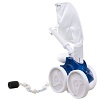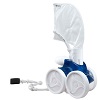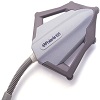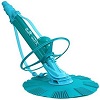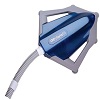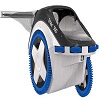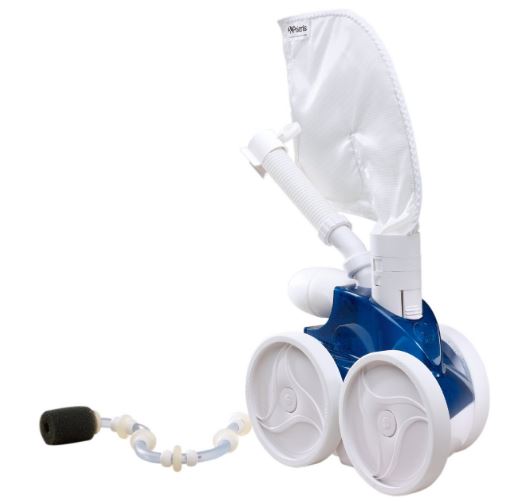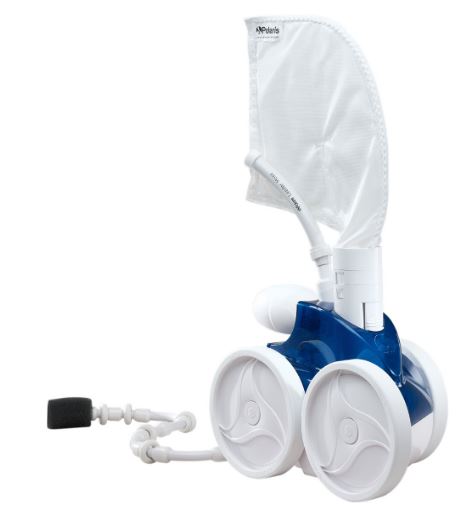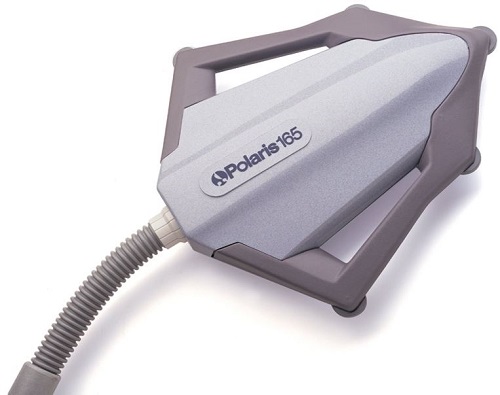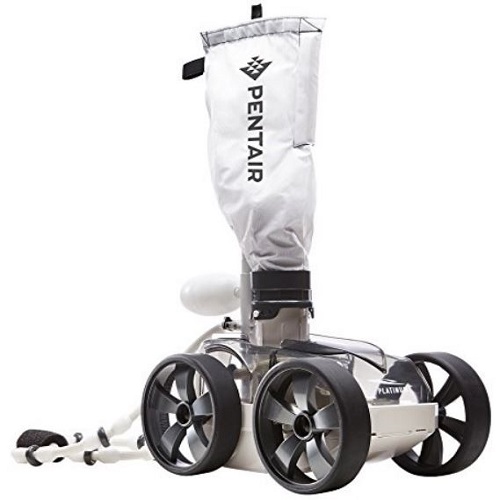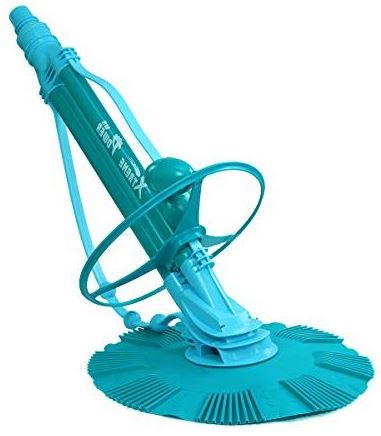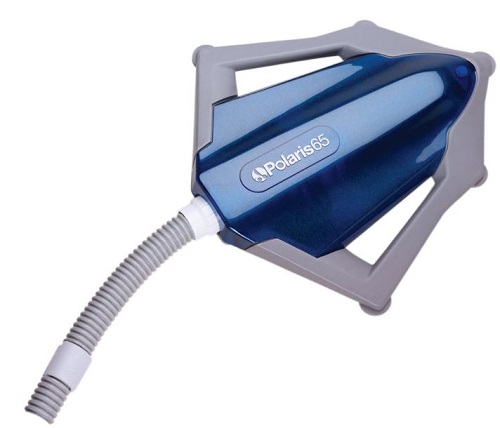Looking for a pressure-side cleaner for your in-ground or above-ground swimming pool?
You’ve come to the right place.
A pressure-side pool cleaner automatically sweeps and vacuums your pool.
Pressure side cleaners don’t need a power connection to work. You only need to connect it to your pool’s return line. It uses the force of water for returning to the pool to move and generate suction.
Pressure pool cleaners rely on your pool’s pump to clean not its filter. These types of pool cleaners have an on-board filter bag that holds leaves and other debris from the pool.
Read on for our reviews of the best pressure-side pool cleaners.
If a pressure pool cleaner doesn’t meet your needs, we recommend suction pool cleaners, if you are looking for a cheaper automatic pool cleaner or robot pool cleaners, if you prefer a cleaner that doesn’t rely on your pool pump and filter.
What's in this Buying guide
Best Pressure Side Pool Cleaners: Comparison Table
- 1. Top Pick(No Booster Pump): Polaris Vac-Sweep 360
- 2. Top Pick (Booster Pump): Polaris Vac-Sweep 380
- 3. Best Value: Zodiac Polaris Vac-Sweep 165
- 4. Best For Larger Pools: KreepyKrauly Platinum
- 5. Budget Pick: XtremepowerUS
- 6. Best For Above Ground Pools: Polaris Vac-Sweep 65
- 7. Largest Debris Bag: Hayward TriVac 500
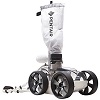
Pentair KreepyKrauly Platinum

- Best for larger pools
Pool Type:
In-groundPrice:
$$$
Best Pressure Side Pool Cleaners: Reviews
If you are looking for a pressure-side pool cleaner that doesn’t need a booster pump, we recommend the Polaris Vac-Sweep 360.
It is one of the most popular pressure pool cleaners. The ‘no booster pump’ advantage is one of the reasons pool owners love it.
It’s easier to set up and uses less power compared to pressure cleaners that require a booster pump.
The Vac-Sweep 360 relies on a triple jet system and a tail scrubber to clean your in-ground swimming pool.
Having three jets gives it more power compared to the Polaris 280 with its two venturi jets. This allows it to clean a bit faster and pick up more debris.
The scrubber that trails the main cleaner deals with the more stubborn debris – algae, scale, and any grime stuck on the pool floor and walls.
The cleaner then sucks up the debris through the large 2¼” inlet. It picks up everything from fine dust and silt to leaves and acorns.
A large onboard filter bag holds the debris. The bag has a tight weave that traps both fine and large debris.
The bag is a bit tricky to clean when wet. We recommend buying an additional bag or two. That way, you can attach a fresh bag on the cleaner and leave the other one out to dry. It’ll be much easier to clean when dry.
As for setup, the Vac-Sweep 360 takes about half an hour to install in your pool. The included manual could do with more detailed instructions, but there are plenty of helpful videos online.
The Vac-Sweep 360 comes with 31 feet of hose lengths, but you can order more if your pool is longer.
Similar to other pressure pool cleaners, you’ll need to adjust the pressure on the return line to get the cleaner to move and clean properly.
Thankfully, you don’t have to install a booster pump.
Pros
- No booster pump required.
- Easy to set up.
- Great cleaning performance.
- Large filter bag.
- An in-line back-up valve keeps the cleaner from getting stuck.
Cons
- Inadequate setup instructions.
- The filter bag is tedious to clean when wet.
If you are looking for a cleaner with more power than the Polaris Vac-Sweep 360, we recommend the 380.
Like the 360, it’s powered by triple jets. However, it relies on a booster pump to generate the right amount of return pressure to move and pick up debris.
The added power makes it suitable for large in-ground pools since it can move around faster without compromising cleaning performance. The average cleaning time for a standard in-ground pool is 3 hours.
The Vac-Sweep 380 also does a better job cleaning the pool walls and steps.
If it gets stuck, the 380 has an in-line back-up valve that reverses the cleaner to free it. So you don’t have to rescue it when it gets stuck. It can take care of itself.
The Polaris 380 comes with a large capacity debris bag that captures both large and fine bits of debris. The bag is easy to detach but a pain to clean.
Let it dry first before you attempt to remove the captured debris. You may need to buy additional bags to use with the cleaner while the other one dries.
Setting up the cleaner is an easy task. Everything you need is included.
However, you may need to adjust the return line pressure to get the cleaner to work properly. It’s a bit of a trial and error process to achieve the right cleaning speed and coverage.
As I mentioned, you’ll need a booster pump for the Polaris 380. If you don’t already have a booster pump installed, get one when you buy the pool cleaner.
Pros
- Excellent cleaning performance.
- Onboard filter bag – protects and lengthens the lifespan of your pool filter.
- Cleans fast.
- Includes tail scrubber to dislodge stubborn dirt.
Cons
- It requires a booster pump, which is sold separately.
- Pricey.
Want a good deal on a pressure pool cleaner? The best one we’ve found is the Zodiac Polaris Vac-Sweep 165.
It’s one of the most affordable pressure-side pool cleaners which cleans your pool almost as well as most of the pricier models.
The Vac-Sweep 165 is designed specifically for fiberglass and vinyl in-ground pools.
It doesn’t have a scrubber like other Polaris automatic cleaners. Instead, it uses powerful jets of water aimed at the wall and floor of the pool to loosen dirt and algae.
If your pool is very dirty – e.g., when you first open it for the season – we recommend manually scrubbing it first before using the Vac-Sweep 165.
But for every day cleanings, the Vac-Sweep 165 is good enough.
It has an on-board debris bag that captures leaves, acorns, silt, and algae before they can reach the pool filter.
The Polaris Vac-Sweep 165 has a few problematic issues you need to know about before you buy it.
For one, it takes a lot of trial and error to get it working correctly. All pressure pool cleaners require some adjustment, but the Vac-Sweep 165 is more tedious to set up.
It takes a few tries to get the right hose length, and you may also need to adjust the pressure on the return line.
It also has a tendency to get stuck or move only in one direction, requiring you to come to its rescue.
If you don’t mind the extra attention it requires, the Polaris Vac-Sweep 165 is a good bargain. And, as a bonus, it doesn’t need a booster pump.
Pros
- Good value for money.
- Cleans well.
- Onboard filter bag.
Cons
- Gets stuck sometimes.
- It takes time to set up properly.
The KreepyKrauly Platinum is one of the most powerful pressure-side pool cleaners.
The dual-thrust water jets produce more power, allowing the cleaner to clean faster and pick up more debris. It also boasts a wider vacuum port and a bigger debris bag.
All these features make it a good choice for large in-ground pools, especially those that get a lot of leaves and acorns from nearby trees.
Unlike the 3-wheeled Polaris pool cleaners, the KreepyKrauly Platinum moves on four wheels. This gives it more stability in the pool, allowing it to move faster and cover the entire pool without getting stuck.
The wheels are wide and treaded, giving them a better grip on the slick pool surface.
That, combined with the front-wheel-drive system, improves traction, especially when the cleaner is scaling the wall or moving over pool features such as the drain.
The KreepyKrauly Platinum picks up debris with ease. A wide vacuum port allows it to suck in large bits of debris like leaves and acorns along with finer debris like silt and algae.
The onboard debris bag holds a lot of debris so you can leave the cleaner in the water for a long time before you need to empty it.
Overall, the KreepyKrauly Platinum is well worth the high price tag. It cleans better and faster.
The only issue is maintenance. Several parts, including the bag and wheels, are not made to last, meaning you have to replace them regularly. This increases maintenance cost, something you have to factor in your budget when buying the Platinum.
Pros
- Great for large pools that get a lot of debris.
- Large debris bag.
- Full pool coverage.
- Cleans fast – cleans most in-ground pools in 1-3 hours.
Cons
- Pricey.
- Higher maintenance costs compared to other pool cleaners.
If you are on a budget, the XtremepowerUS is one of the cheapest pressure-side pool cleaners you’ll find.
Reviews for this model are mixed with just as many customers giving it a 5-star rating as those who rate it 1-star.
The main problem with the cleaner is build quality, which is not surprising considering the price tag. If you decide to buy it, expect it to last for just one or two seasons.
That’s too bad because it cleans quite well. It picks up both large and small debris while a tail scrubber dislodges the more stubborn dirt.
An on-board filter bag collects all the debris. It captures both fine and large bits, so you don’t have silt constantly sitting at the bottom of the pool.
As long as you don’t mind having the cleaner for just a couple of years before it gives out, the XtremepowerUS pressure pool cleaner is a good choice.
Note that you’ll need to have a booster pump installed to use the XtremepowerUS pressure pool cleaner. The pump is not included along with the cleaner, so add it to your budget if you don’t already have a booster pump.
Pros
- Picks up all kinds of debris.
- Onboard debris bag.
- Easy to set up.
Cons
- It doesn't last long – 1-2 seasons.
- It requires a booster pump, which you have to buy separately.
If you have an above-ground pool, we recommend the Polaris Vac-Sweep 65. It is an affordable pressure-side pool cleaner designed specifically for above ground pools up to 5ft deep.
The Vac-Sweep 65 has the same flat profile as the Vac-Sweep 165 with a filter bag trailing the cleaner as it picks up debris.
The cleaner uses water jets to dislodge debris off the pool floor. For most vinyl above ground pools, this is enough to get most of the dirt out of the pool.
Set up is easy and quick. The Polaris Vac-Sweep 65 comes with 24 feet of hose lengths that are easy to hook up together.
Attach one end to the return line on your above ground pool and the other to the pool cleaner. This leaves your pool filter and skimmer working as normal with no interference.
Make sure you’ve set up the pool cleaner correctly. Most of the problems customers encounter have to do with how they installed it.
You may need to adjust the pressure on the return line to make sure the cleaner is moving in the right place. It should be moving slowly to ensure it picks up debris.
You may also need to trim the hoses to prevent coiling, a very common problem for pool owners using the Vac-Sweep 65.
Overall, we think the Polaris Vac-Sweep 65 is an excellent choice for above ground pool owners. Just be ready to go through some trial and error to get it working properly.
But it’s worth it. It makes it so much easier to keep your pool debris-free.
Pros
- Great cleaning performance.
- Affordable.
- Easy to set up.
- It doesn't need a booster pump.
Cons
- Requires some adjustments to work well.
If your pool is located near large trees, you probably have to clean the pool every day to deal with the leaves.
Switching to an automatic pool cleaner will make your work so much easier. We recommend the Hayward TriVac 500.
Most other pressure-side pool cleaners will pick up the leaves. But their debris bags will fill up quickly, requiring you to remove the cleaner and empty the bag constantly.
The TriVac 500 has the largest debris bag we’ve seen in any pressure-side pool cleaner. It holds a lot of debris, allowing the cleaner to keep going for longer before you need to empty the bag.
Many pool owners say they can go for as long as a week before the debris bag fills up.
The cleaner itself is designed to pick up all types of debris from fine silt to leaves and acorns. It deploys a triple-jet venturi that sucks up debris through the wide inlet.
The TriVac 500 has a unique navigation system that ensures full pool coverage. It has built-in back-up sequences that allow it to change direction every now and then.
This ensures it doesn’t just move in one direction or spend its time going round the same spot. It covers every part of the pool, including the floor (even the deep end), cove, and walls.
You’ll need to install a booster pump for the TriVac 500 to work properly. You can order the Hayward pump the same time you buy the cleaner.
You can install the pump yourself.
Pros
- Excellent cleaning performance.
- Extra-large debris bag – perfect for leafy pools.
- Full pool coverage with few or no missed spots.
- Excellent build quality – last for years with minimal maintenance.
Cons
- Requires a booster pump.
Buyer's Guide: 13 Things To Consider
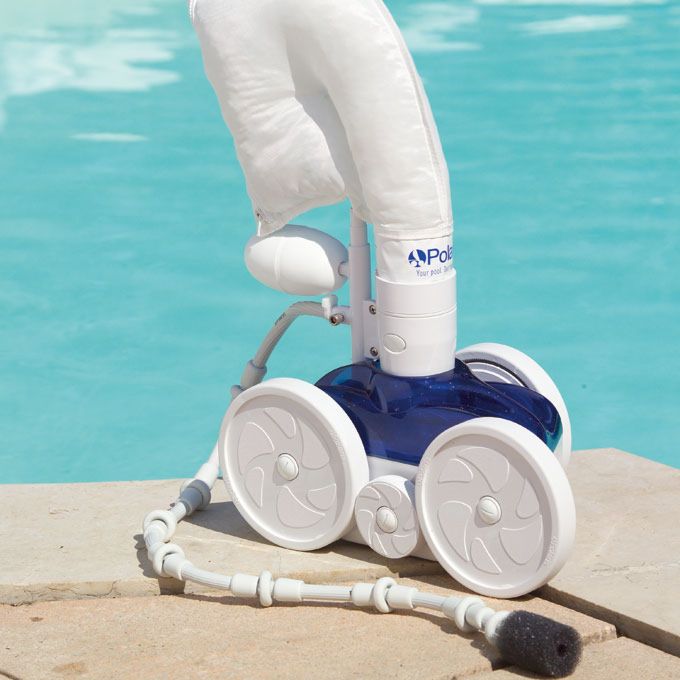
Here’s what to consider when you are shopping for a pressure-side pool cleaner.
1. Types of Pressure Side Cleaners
Pressure line fed: These pressure cleaners rely on your pool’s main pump for power. Just connect it to your pool’s pressure line, and it’ll work fine.
Booster pump-fed: These pressure cleaners also connect to your pool’s return line, but they get their power from a booster pump. You’ll have to install a booster pump before using the cleaner.
If you are on a budget, a pressure line fed cleaner is the best since you don’t need to invest in a separate booster pump.
If you have a large swimming pool, get a cleaner that works with a booster pump. It’ll provide better pool coverage (floor, walls, and waterline) and more thorough cleaning.
2. Boost Pump Cost & Installation
If you decide to get a booster pump-fed pool cleaner, check how much it’ll cost you to buy and install the booster pump.
If the company’s booster pump is expensive, you can get one from another brand. Any good quality booster pump will work.
We also recommend getting a booster pump that you can install yourself. It’ll save you on installation costs.
Of course, if you have a more generous budget, go ahead and buy the best booster pump you can get and have a pool pro install it for you.
3. Swimming Pool Size and Shape
Swimming pool size doesn’t matter much when it comes to selecting the right pressure side pool cleaner.
As long as you buy a pool cleaner that’s right for your type of pool – in-ground or above ground – it’ll clean any pool shape.
But the size is important. The hose length determines how big of a pool a cleaner can vacuum.
Most in-ground pressure pool cleaner can vacuum a 32′ swimming pool while above ground pool cleaners can cover a 24′ swimming pool.
If your pool is smaller than that, remove one or two hose lengths to prevent the hose from tangling.
If your pool is larger than that, order additional hose lengths to ensure the cleaner can reach all parts of the pool.
4. Pool Type
Before you buy a pool cleaner, check what type of pool it’s meant to be used in.
Some pressure-side pool cleaners can work in any type of pool, but some are designed specifically for fiberglass, vinyl, or gunite pools.
Using the wrong type of cleaner in your pool could damage your pool’s lining.
5. Size of Debris Bag
All pressure-side pool cleaners come with an attached debris bag. If your pool doesn’t get a lot of debris, the size of the bag doesn’t matter.
But if your pool gets a lot of leaves, twigs, and acorns from nearby trees, look for a pool cleaner with a large debris bag. We recommend the Hayward TriVac 500, which we’ve reviewed above.
A larger debris bag saves you the trouble of constantly emptying the debris.
6. Scrubber
Most pressure-side pool cleaners have a scrubber tail that trails the cleaner. The tail has a scrubber at the end that loosens dirt from the pool surface, making it easier for the cleaner to vacuum it.
The scrubber isn’t nearly as thorough as a manual pool brush or the scrubbing brushes on a robotic pool cleaner. Don’t expect it to remove all the built-up algae and grime.
While it’ll help with day-to-day cleaning, you’ll need to brush the pool manually for a deeper clean occasionally.
7. Pool Coverage
Check which parts of the pool the cleaner can clean. It’ll let you know how much manual pool cleaning you still need to do.
Cheaper pressure pool cleaners only cover the floor, leaving you to scrub the steps and walls manually.
This may not be a big deal for above ground pools since they are smaller and shallower (in fact, most above ground pool cleaners only vacuum the floor), but can leave you with a lot of work if you own an in-ground pool.
To make pool maintenance easy, spend more money on a capable pool cleaner that can go up the wall and clean the steps as well.
8. Back-up Valve
Most pool owners don’t think about this one, but it is incredibly useful. A back-up valve reverses the flow of water, allowing the pool cleaner to move in reverse.
This has two benefits.
- The cleaner can free itself when it gets stuck by backing up.
- The cleaner can change direction more efficiently, which improves pool coverage.
9. Build Quality
Build quality is generally proportional to price. The more you spend, the better quality you get.
A cheap pressure-side pool cleaner will likely have flimsy plastic parts that break or get loose within months. Most budget pool cleaners last for just a couple of seasons before you need to buy a new one.
A good quality pressure pool cleaner, on the other hand, can last for years with very little maintenance.
10. Ease of Installation
Installing a pressure-side pool cleaner is usually a DIY job. But, depending on the type and quality of cleaner you get, it can take you anywhere between half an hour to several hours to get it clean.
The tricky bit is adjusting hose length and your pool’s return pressure.
The hose has to be the right length to keep it from tangling while allowing the cleaner to reach the entire pool.
The right water pressure is essential to ensure the cleaner doesn’t move too fast that it misses debris or too slow that it stalls.
A quick look through customer reviews will give you an idea of how other pool owners fared with setup.
11. Warranty
The standard warranty for pressure-side pool cleaners is one year. A shorter warranty than that should give you pause, as it is an indication of lower build quality.
Make sure you read the warranty carefully to find out what’s covered and what isn’t.
12. Customer Service
Most people don’t think much about a company’s customer service until after they’ve bought the pool cleaner.
That’s when they need to contact the company for help with installation or to sort issues with damaged or missing parts.
Major companies like Polaris and Hayward have reputable customer service. They respond quickly and will usually replace a faulty part for free, even if you are the one who damaged it.
Smaller less-known brands, especially those that sell cheaper cleaners, may have less than stellar customer service.
For your sanity, stay away from them.
13. Price
Finally, consider the cost of the pool cleaner.
Pressure-side pool cleaners generally fall between suction-side cleaners and robotic pool cleaners.
Prices range from around $200 for budget cleaners and above-ground pool cleaners to $700 for high-end in-ground pool cleaners.
Don’t forget to factor in the cost of a booster pump, if one is needed. This can push the overall cost to between $500 and over a thousand dollars.
Pressure Side Pool Cleaner FAQs
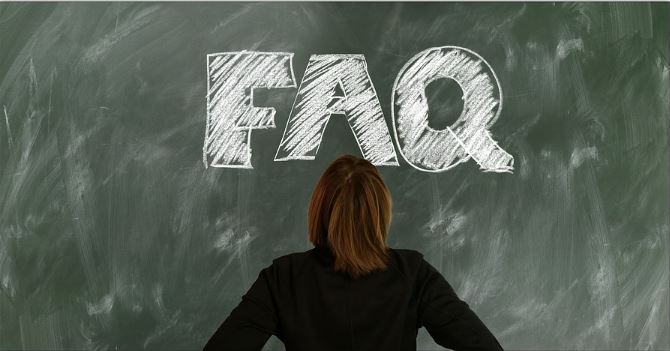
How Do I Install A Pressure Side Pool Cleaner?
Installing a pressure-side pool cleaner is easy. It takes about half an hour.
The most important thing to understand is that a pressure-side pool cleaner connects to your pool’s return line.
Unlike a suction pool cleaner that’s powered by the force of water going out of the pool, a pressure pool cleaner is powered by water returning to the pool.
First, assemble the main unit if it needs any assembly. Usually, you just need to attach the filter bag and the tail scrubber.
Then connect all the hose lengths making sure the leader hose is at one end. This is the hose that will connect to the cleaner.
Remove or add hose lengths as necessary, depending on the size of your pool.
With the hose assembled, turn the pool pump off and dunk the cleaner in water. Hold it for a few seconds until all the air inside is displaced.
While keeping the cleaner underwater, attach the leader hose to it. Release the cleaner and slowly let it sink to the bottom. Let go of the hose a little at a time, giving it time to fill with water.
When the entire hose is underwater, attach the free end to your pool’s return line using a universal wall fitting.
Observe the cleaner to make it is working properly.
If it seems to be moving too fast or is not moving, adjust the return pressure. If it tips upwards or to the sides or doesn’t go up the wall, you may need to add one or two more hose sections.
If the hose is tangling, you may need to remove one or two hose lengths.
As always, the product manual should be your main guide. If you encounter a problem, contact the company’s customer support.
How To Operate a Pressure Side Pool Cleaner?
A pressure-side pool cleaner, or any automatic pool cleaner for that matter, doesn’t require you to operate it.
Once you’ve set it up and it’s working as expected, let it do its thing.
All you need to do is empty the debris bag when it fills up.
How To Maintain a Pressure Side Pool Cleaner?
- Empty the debris bag frequently. If it's holding too much debris, the cleaner won't work properly and might even stall.
- Every week, remove the cleaner and check for any trapped debris, especially around the vacuum port and the wheels.
- Replace parts as needed. These include wheels, the debris bag, back-up valve, and tail scrubber.
Robotic vs. Pressure vs. Suction Pool Cleaners
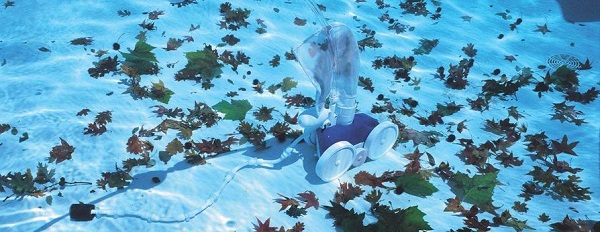
These three are all automatic pool cleaners. That is, they offer hands-free cleaning.
Beyond that, there are plenty of differences between them.
Here’s a quick summary of each.
Robotic pool cleaners are the most advanced automatic pool cleaners. They have an onboard filter bag or bin and connect to a power source instead of relying on the pool pump.
They are the only automatic pool cleaners that don’t rely on the pool pump or filter.
Pressure-side pool cleaners use the force of water returning to the pool to move and pick up debris. Therefore, they rely on the pool pump for power. But they hold the debris they collect in a debris bag, instead of directing it to your pool filter.
Suction-side pool cleaners are the cheapest and most basic types of automatic pool cleaners. They use the force of water going out of the pool to move and pick up debris.
Suction cleaners rely on both the pool pump and filter to clean the pool.
Conclusion
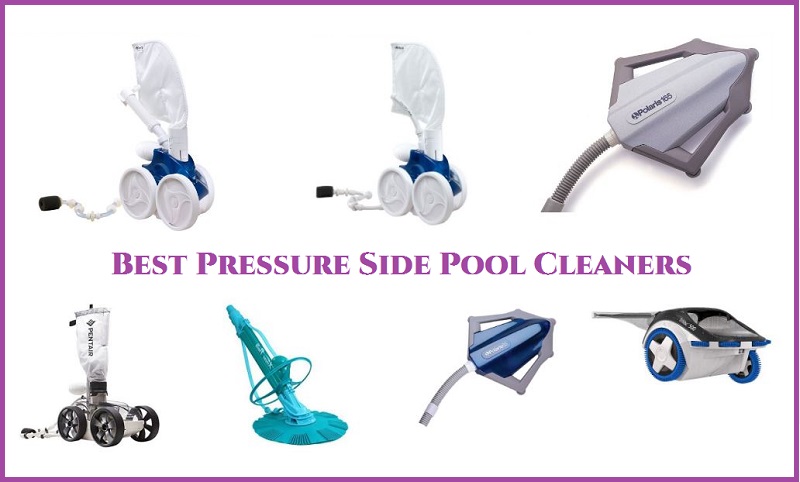
Pressure-side pool cleaners are a cheaper alternative to robotic pool cleaners. For less money, you get almost the same level of cleaning.
They are easy to set up, easy to maintain, and, most importantly, they make pool maintenance easier and cheaper (no need to pay a pool boy!).

